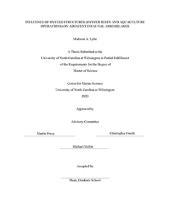
Abstract
Predators ’ use of structural habitats is often associated with a shift in the abundance and/or composition of infaunal communities in the adjacent soft substrate. This alteration of the infauna is often referred to as a “halo effect ”. The halo effect is one factor that can be used to evaluate utilization patterns of structural habitats. Shellfish themselves and aquaculture gear used for shellfish grow-out provide structural habitat in otherwise unstructured soft-bottoms areas. Shellfish provide many ecosystem services, influence habitat complexity, provide settlement surface for sessile invertebrates, and attract economically and recreationally important fisheries ’ species. Few studies have examined habitat utilization of shellfish aquaculture relative to wild or restored oyster reefs. We looked at how various oyster structures (shellfish aquaculture and natural and created oyster reefs) in different locations differed in habitat impacts and whether they displayed halo patterns for infauna in adjacent soft substrates. Comparisons of relative mean abundances of infaunal functional guilds (feeding modes and living positions) and relative mean abundances of dominant taxa based on distances from oyster structures were made. Nekton mean abundances and relative predation was investigated to provide insight on nektons ’ use of soft-bottoms adjacent to oyster structures and potential impacts on infaunal abundances. Key findings included similar structural habitat effects among different structural habitat types, but strong location impacts on functional guild and taxa patterns. Halo patterns were detected for several infauna taxa (Cirratulidae, Orbiniidae, and juvenile bivalve species). These results showed similarity in function of different types of oyster structures suggesting replacement of soft-bottoms with artificial structures may provide similar habitat utilization patterns as wild oyster reefs. Strong site differences emphasize the need to include various sites in habitat studies.
About this resource
This thesis was developed by Madison A Lytle in partial fulfillment of the requirements for the degree of Master of Science from the Center for Marine Science, University of North Carolina at Wilmington. Madison was advised by Martin Posey and Troy Alphin, and her field and lab work was partially supported by a grant from the Science Collaborative. This research contributed to studies about the impacts and benefits of oyster farms in different conditions, which can inform the siting and permitting for shellfish aquaculture operations.
Lytle, Madison A. 2020. Influence of oyster structures (oyster reefs and aquaculture operations) on adjacent infaunal assemblages. MS Thesis, University of North Carolina - Wilmington.